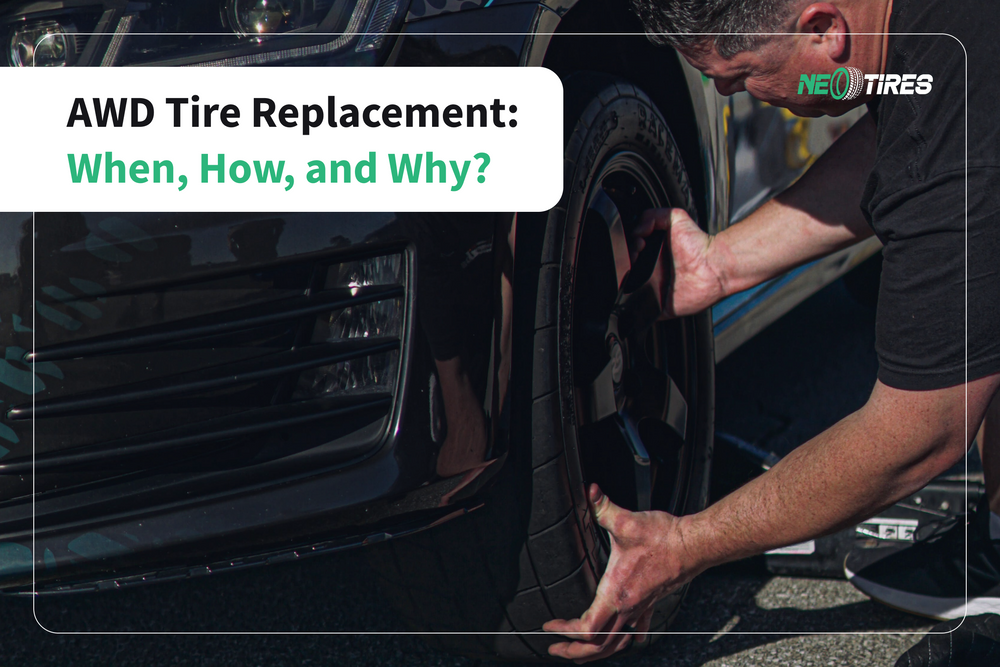Being the owner of an All-Wheel Drive (AWD)vehicle is real luck and pleasure. The traction of the vehicle is so powerful that you have the feeling that nothing can stop it. For all the benefits that come with an AWD, owners face a fairly frequent problem. It is about the fact that the front tires tend to wear off much faster than the rear ones. If you consult a specialist in the field, he will tell you that there is not just a single reason for this. Rather, it is a set of reasons that lead to the predominance of front tires being affected.
First of all, it is about the natural force that presses the front tires every time during steering and brakeing. Secondly, AWD car owners love to test their forces and often adopt an aggressive driving style. The vehicle copes with this style without problems, but this entails damage to the front tires. Last but not least, the front tires often deteriorate as a result of the driver's negligence. Improper pressure, lack of tire rotation, or avoiding wheel alignment, all lead to earlier degradation of the front tires compared to the rear ones.
The problem is that once 2 tires wear out, it is necessary to replace all 4 wheels with an AWD, to avoid uneven wear. So the owners are a bit confused about the tires for an AWD and I thought I would address this topic in more detail. Let's see when it's time to change tires for an AWD and under what circumstances.
"All-Wheel -Drive Vehicle" by Definition
First things first. What defines an AWD vehicle? And how is it different from other types? The answer is very simple. An AWD vehicle refers to a means of transport in which each of the wheels can move forward independently of the other. To optimize traction, AWD wheels automatically shift the power between the front and back wheels without depending on each other.
In contrast, the FWD system assumes that the car transmits torque to the front wheels and only then to the rear wheels. With the RWD scenario, the torque addresses the rear wheels and only then the front ones. In conclusion, the All-Wheel-Drive system is a set of technical processes that transmit torque to all 4 wheels simultaneously.
Common Confusion Between All-Wheel Drive And 4-Wheel Drive
I hope the difference between rear/front-wheel drive and all-wheel drive is clear to you. Now let's move on to another uncertainty that confuses many drivers: the difference between All-Wheel and 4-Wheel Drive. If you thought these 2 terms refer to the same thing, you are wrong.
While AWD is a default system that works permanently, the 4-wheel system alternates between on and off depending on the circumstances. The AWD system works on a variable linkage that the car adjusts along the way whenever it needs to, regardless of speed. Alternatively, the 4WD system connects the 2 rear and front wheels via a transfer case through which the power splits evenly.
Of these 2 options, 4WD is much more agile on rough terrain. At the same time, the drivers of these cars can choose between a low and a high range, depending on the road conditions. For gravel, ice, sand, or severe snow conditions, the high range helps the vehicle handle the conditions perfectly. Alternatively, the low range is suitable when maximum off-road traction is required.
Why Is Tire Replacement On An AWD Different?
Changing only 2 tires for vehicles with front or rear drive makes all sense. It is quite logical to change only those that are more prone to damage and wear. In addition, it is quite cost-effective to buy only 2 tires.
However, such a scenario is not at all welcome for an AWD vehicle. Taking into account that the traction of the car is ensured by all 4 tires, changing only 2 of them leads to tire mismatching.
In the same context, 2 of the tires will wear unevenly compared to the other 2. And keep in mind that the uneven wear will only get more severe over time. These effects lead to other components' damage to the suspension system.
It seems that the temptation to replace only 2 tires is not so dangerous. After all, you exchange them with those who are already far too affected. The other 2 could serve for some more time. But, if that's your way of thinking, know that it's not quite right. You can end up paying double, both for a new set of tires and for the suspension system repair that was affected due to different tire combinations.
Changing All 4 Tires Is Not An Option, It's a Must!
Avoid at all costs replacing just one or 2 tires for your All-Drive vehicle. Apart from the uneven tire wear that you will surely get, you risk severely affecting the drivetrain of your car. Most of the time, deviations between the different tread wear of the tires make the system interpret that the car loses its traction.
Imagine that you are organizing a rowing competition with some of your friends. If at least one of them does not respect the rowing rhythm and speed, the entire rowing process is severely impacted. The same thing happens with the different tires in All-Drive vehicles. If the tires do not coincide with each other, there is a "glitch" in the system that leads to adverse effects.
The variation between the type and wear of the tires is acceptable only for front and rear-wheel drive vehicles. Otherwise, changing them separately in All-Drive will cost you a lot more effort, system damage, and money. In the best scenario, equip yourself with a set of new tires to be prepared in advance for the moment of change. Be prudent with the cheap offerings as they are not always the best, even though the price might sound attractive.
Final Thoughts
If you have had doubts, I hope you now know how important it is to change all the tires on an AWD vehicle. If you care about your car and its long-term serviceability, take care to replace them the right way. And it's not difficult for me to reiterate: if at least one tire has different wear, this leads to the imbalance of the entire power distribution system between the wheels. Also in this context, the system will read the data incorrectly and will slow down the rotation of the tires with a better tread to balance it with the other tires.
According to specialists, the tread life variance from tire to tire should not exceed 3/32nds of an inch for All-Wheel Drive vehicles. Everything that goes over these reference points is dangerous for AWD axles and cases.
The process of changing the tires in an AWD vehicle is certainly more expensive. This is because the specialists change the entire set of tires, unlike the FWD or RWD vehicles. For the latter, it is acceptable to replace only 2.
Even despite the additional cost, you don't have to experiment with the tires of an AWD vehicle. Assume the costs and change them as recommended by the specialists. This will help you avoid much higher costs for major repairs.
AWD Tire Replacement: FAQs
Do You Really Have to Replace All 4 Tires on AWD?
The final decision belongs to the driver, after all. But, according to specialists and experts in the field, changing all 4 tires on an AWD is highly recommended. This recommendation actually applies to all vehicles, but in the case of AWD, it is of particular importance. The 4 tires must be identical in terms of wear, size, pattern, diameter, and brand (if possible) to avoid potential adverse effects on tire condition, performance, and driving safety.
Do Tires on AWD Cars Wear Out Faster?
Taking into account the complexity and weight of these vehicles, you can expect faster tire wear than with other types of vehicles. The point is that AWDs, just like 4WDs, put some extra strain on the wheels. As such, tires can be less resistant to wear and tear. However, the type of vehicle is only one of the factors that influence tire wear. Road conditions and driving style also play an equally important role.
Is It OK to Replace Only 2 Tires on AWDs?
It's not OK at all. While technically possible, replacing only 1 or 2 tires will have negative consequences. First, the tires will wear unevenly. Secondly, the suspension and drivetrain are likely to get damaged in the long term. Thirdly, mismatching tires can cause performance conflicts and traction confusion.
Should You Rotate Tires on AWD?
Absolutely. More than that, specialists recommend more frequent rotation with an AWD than in other types of vehicles. The specifics of AWD vehicles consist of the full engagement of all 4 tires to provide traction. This makes them wear out relatively faster than in other vehicles. More often rotation evens out their wear and extends their lifespan.
Is AWD Tire Replacement More Expensive?
Yes, AWD owners pay more for tire replacement than FWD or RWD owners. The reason is simple: an AWD requires the replacement of all 4 tires. In contrast, those driving an FWD/RWD are allowed to replace only two tires if the condition of the other 2 is still acceptable.
How Often Should You Rotate AWD Tires?
While the tires of other types of vehicles are usually rotated at 5,000-7,000 miles, the AWD ones should be rotated around 3,500- 5,000 miles. It is recommended that drivers regularly inspect the condition of the tires on their AWD vehicles. Sometimes, the rotation might be necessary even earlier, depending on the road conditions and driving style.
Why Trust Us?
Tires can substantially improve or worsen driving quality and performance. Depending on the formula, technologies, tread, and construction, they define the degree of safety and performance in various weather and road conditions. Leave the choice of the right tires in professional hands. NeoTires is a team in which each member has professional knowledge about all that tires mean by definition. Our experience in this field is confirmed by thousands of drivers across the US who have already benefited from our assistance and products.
Here at NeoTires, we are fully dedicated to tire study, comparison, and reviews. We analyze them from different performance perspectives and in various conditions to know what are the benefits and shortcomings of each product at a professional level. Here we can consult you about best driving tips, safety recommendations, and tire maintenance tricks to benefit from optimal serviceability of your tires. Last but not least, we are committed to finding the best tire deals so that you can enjoy an advantageous price. Drive safe and choose your tires wisely!





